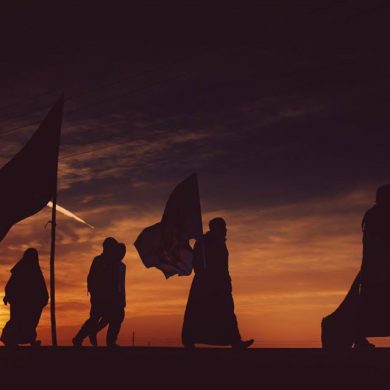In the story of the death of Imam Hussain (maqtal), which people read every year on Ashura, is the story of Jon bin Huway, his loyal companion. They narrate that Jon said to Imam Hussain (a.s) before going out to battle:
“By Allah, my smell is foul, and my lineage is lowly, and my colour is black, so breathe upon me in jannah so my smell becomes like perfume, and my lineage becomes honourable, and my face is whitened. By Allah, I will never leave your side until this black blood becomes mixed with your blood!”.
He then fought until he was killed, so Imam Hussain (a.s) came and stood by him saying: “Oh Allah, whiten his face, make his scent like perfume, and resurrect him with the righteous, and make him close to Muhammad and his Ahlulbayt”.
There are many mistruths presented in this narration. This story assumes that black skin colour is inherently bad, and that this causes the person to have a foul smell and a dishonourable lineage. It also says that the blood of a black person is black as well. How can there be black blood? Blood is always red, regardless if the colour of the skin is black or white. In contrast to this negative depiction of people with black skin, the story also implies that white skin is the better colour, and that it makes a person have a nice smell and an honourable lineage.
Is it possible that Imam Hussain (a.s) would support these ideas? Of course not! Is he not the great leader who embodies Islam, whose central principle is to combat discrimination and have equality for all people? The Qur’an stresses that “the most noble of you is the one who has the most taqwa” (Qur’an 49:13).
Further, is it logical that a such a pious follower of Ahlulbayt (a.s) who had incredible knowledge through learning from Imam Ali (a.s) and Abu Dhar, like Jon, would ever say something so discriminatory?
In Islamic history, there were many great personalities who had black skin, from Bilal Al-Habashi, the mu’edhin of Rasool-ullah, to Jon the great martyr of Karbala, to Sa’eed ibn Jubayr, the scholar who was killed by Al-Hajjaj Al-Thaqafi. Further, there are many narrations which state that the Prophet and his family were of a darker complexion and no way near as white as they are often depicted.
When did skin colour become something to be embarrassed about? This is the logic of Banu Umayyah, the logic of colonialism, and the logic of ignorance and distance from faith. It is a mindset strongly rejected by Islam.
When will we purify our hadiths from these foreign insertions and falsehoods that are far from the spirit of Islam, especially since this issue is related to the revolution of Imam Hussain (a.s), that aimed for reformation and revival of the original Islamic principles. It is imperative for us to understand that the Qur’an is the only certain truth, anything else is a historical narration that has the potential to be incorrect.
Our role is to compare the historical narrations with the true Islamic teachings presented to us in the Qur’an. If they align, then they are true. If there are contradictions then the narration is not true. In the case of the dialogue between Imam Hussain (as) and his noble companion Jon bin Huway, it contradicts the teachings in Islam of equality and in the Qur’an as in the verse above. Let us be careful about what we attribute to our Holy Imams, lest we spread mistruths about them and consequently, about Islam.
This article was originally written in Arabic by Dr. Iman Alattar.






